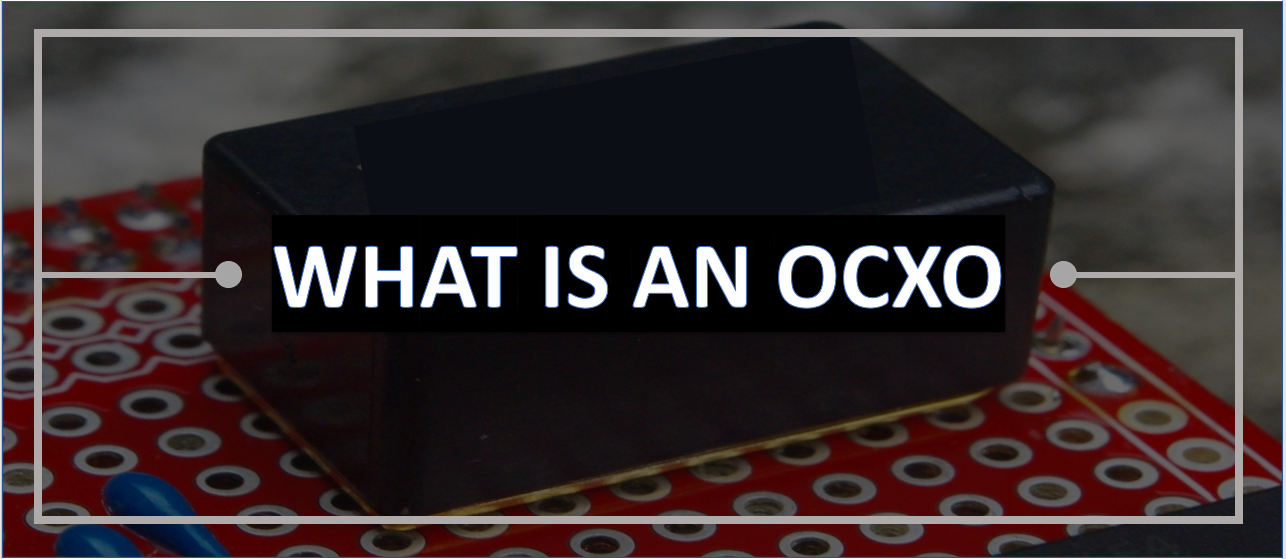
OCXO stands for “Oven Controlled Crystal (Xtal) Oscillator”. It is a quartz crystal-based timing device (clock) used in precision timing functions. Its high frequency stability makes its signal more precise and offers outstanding aging performance relative to the other quartz crystal oscillators: Temperature Controlled Xtal Oscillator (TCXO), Voltage Controlled Xtal Oscillator (VCXO), and Xtal Oscillator (XO).
An OXCO can see an improvement of up to 100 times better frequency vs. stability compared to un-ovenized quartz crystals. The following table shows the relative stability of different frequency control devices.

How OCXOs Work
The quartz crystal inside an OCXO is heated by an oven-like device. The oven has precise temperature control and heats the crystal to its turnover temperature, maintaining it throughout the duration of its use. This helps keep the crystal temperature constant and prevents fluctuations from external temperature changes, which compromises its desired frequency stability.
The cut of the quartz crystal affects OCXO performance. There are two types used in OCXOs: AT cut and SC cut.
AT cut crystals are more widely used in OCXOs and are preferred for a wide temperature range. SC cut crystals provide a higher level of frequency stability and precision compared to AT cut due to its lack of stress sensitivity. Without stress sensitivity, the crystal does not have a transient response to temperature changes. SC cut crystals are more suitable for elevated operating temperatures.
Applications and Considerations
OCXOs are best for operations that require better frequency stability and precision clocking, like the 5 GNSS Constellations (GPS, QZSS, BEIDOU, GALILEO, and GLONASS). Applications include any operation requiring GPS, like military data links and test equipment. They can be paired with atomic clocks to provide both short-term and long-term stability, as opposed to just the long-term stability atomic clocks offer.
However, OCXO’s low phase noise, exceptional aging performance, and high stability come at the expense of high-power consumption. This makes OCXOs less desirable for battery powered devices. OCXOs also require a prolonged warm-up period, which initially requires more power consumption. The power use, as well as frequency fluctuations, stabilize once the device reaches its desired steady-state internal oven temperature. This is a drawback compared to TCXOs and XOs, which do not require a significant warm up time and can reach the specified frequency instantly.
Dynamic Engineers, Inc offers a wide range of OCXOs featuring low power consumption and multi-phase outputs. Find the perfect solution for your project.
For a more comprehensive list of applications, please check our OXCO devices by clicking here.
Model | Features | Application |
OCXO3311C | - Shock resistant(500G half sine)
- Small size: 16x15.3x10.5mm
- Low power consumption:180mW Typ.
- Fast warm-up: 60s Typ.
High stability: ±10PPB from -40C to +85C
| - Portable Wireless Communications
- Mobile Test equipment
- Beacons & Rescue systems
- Battery Powered Applications
- Base Station
- Equipment working at severe mechanical factors
|
OCXO3320AW | - Low height 7.5mm
- Small size: 16x15.3x7.5mm
- Low power consumption: 180mW Typ.
- Fast warm-up: 60s Typ.
- High stability: ±10PPB from -40C to +85C
| - Portable Wireless
- Communications
- Mobile Test equipment
- Beacons & Rescue systems
- Battery Powered Applications
- Base Station
|
OCXO3321AW02 | - Ultra-low power consumption: 90mW Typ.
- Fast warm-up: 60s Typ.
- High stability: ±2PPB from -40C to +85C
| - Portable Wireless
- Communications
- Mobile Test equipment
- Beacons & Rescue systems
- Battery Powered Applications
- Base Station
- Synthesizers
|
DOCXO3627C_series | - High stability: ±0.05PPB from -30C to +70C
- Low aging: ±0.1PPB/ Day
| - Rubidium Standard
- Replacement
- Stratum 2 Clock Systems
- Instrumentation
- Timing Module
- Base Station
- Instrument Reference
|
DOCXO2020C_series | - High stability: ±0.1PPB from -40C to +85C
- Small size: 20x20x12.9 mm
- Low aging: ±0.2PPB/ Day
| - Rubidium Standard Replacement
- Stratum 2 Clock Systems
- Instrumentation
- Timing Module
- Base Station
- Instrument Reference
|